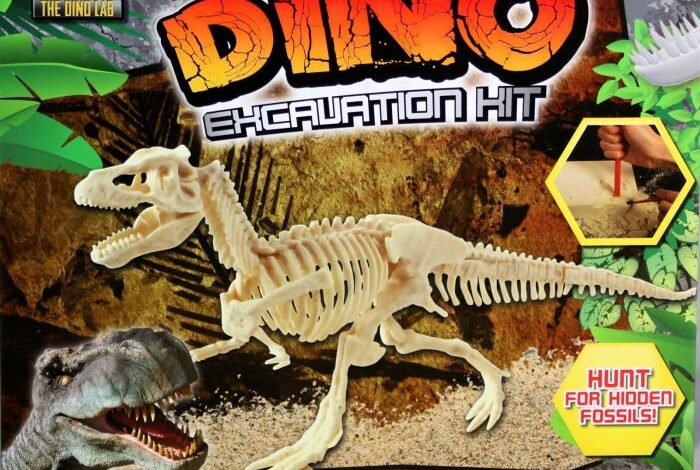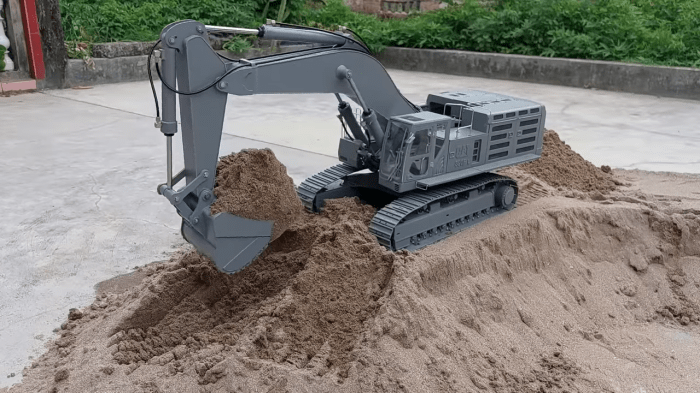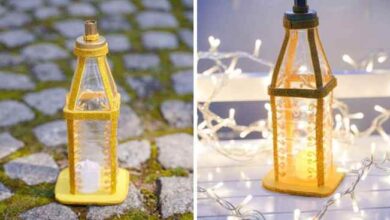
Excavation Kit DIY: Unearth Fun and Learning
Excavation Kit DIY: Imagine the thrill of discovering hidden treasures! Building your own excavation kit is a fantastic way to bring the excitement of archaeology and paleontology right into your home. From unearthing fossils to unearthing ancient artifacts, these kits are perfect for sparking curiosity and igniting a passion for exploration in kids and adults alike.
With a little creativity and some readily available materials, you can craft an engaging excavation experience that will leave everyone wanting more. We’ll guide you through the process, from selecting the perfect materials to designing the excavation experience, ensuring both safety and educational value.
Introduction to Excavation Kits

Excavation kits are engaging and educational tools that allow individuals to experience the thrill of discovery by unearthing hidden treasures. These kits typically contain a block of material, such as plaster or clay, that encases a fossil, artifact, or mineral specimen.
Building your own excavation kit can be a fun and rewarding project, especially if you’re planning a themed party or just want to unleash your inner archaeologist. And what better way to celebrate your newfound digging skills than with a good old-fashioned water fight?
Check out some cool water fight ideas to make your excavation party even more memorable. Of course, you’ll need to make sure your excavation kit is ready for a good soaking, so maybe add a waterproof layer to your design!
By using provided tools, like chisels and brushes, users can carefully excavate the specimen, revealing its hidden beauty and learning about its history.Excavation kits are designed to provide an interactive and hands-on learning experience, fostering a sense of wonder and curiosity about the natural world.
They are particularly popular among children and adults interested in paleontology, archaeology, geology, or simply enjoying the excitement of discovery.
Types of Excavation Kits
Excavation kits come in a variety of types, each catering to a specific area of interest. Here are some common types:
- Fossil Excavation Kits:These kits typically contain fossilized remains of prehistoric animals or plants, such as dinosaurs, trilobites, or ancient plants. They provide an opportunity to learn about extinct life forms and the process of fossilization.
- Artifact Excavation Kits:These kits focus on unearthing historical artifacts, such as ancient coins, tools, or pottery shards. They offer insights into past civilizations and their way of life.
- Mineral Excavation Kits:These kits feature a selection of raw minerals, such as crystals, gemstones, or ores. They provide an introduction to the fascinating world of mineralogy and the properties of different minerals.
Benefits of Creating a DIY Excavation Kit
Creating a DIY excavation kit allows for a more personalized and cost-effective learning experience. It offers several benefits:
- Customization:You can choose the specific specimen or theme that interests you, allowing for a tailored learning experience.
- Cost-effectiveness:Creating your own kit can be significantly cheaper than purchasing a pre-made kit, especially if you have access to materials.
- Educational Value:The process of creating the kit itself can be an educational experience, allowing you to learn about the materials and techniques involved in creating an excavation kit.
- Creative Expression:DIY kits provide an opportunity to express your creativity by designing and crafting your own unique excavation experience.
Materials and Supplies
Assembling your DIY excavation kit requires a strategic selection of tools and materials. This section will guide you through the essentials, categorized by function, to ensure you have everything you need for a successful digging experience.
Digging Tools
Digging tools are the heart of your excavation kit, allowing you to unearth hidden treasures and uncover fascinating geological formations.
- Shovels:Choose a shovel with a sturdy, lightweight handle and a sharp, pointed blade. A long-handled shovel is ideal for larger areas, while a short-handled shovel is perfect for smaller spaces or working around obstacles.
- Trowels:Trowels are essential for precise digging and removing delicate items. Opt for a trowel with a comfortable grip and a sharp, pointed blade.
- Hand Pick:A hand pick is a versatile tool for breaking up hard soil, rocks, and roots. Look for a pick with a strong head and a comfortable grip.
- Brushes:Brushes are crucial for cleaning artifacts and revealing details. A soft-bristled brush is ideal for delicate items, while a stiff-bristled brush is better for removing dirt and debris from larger items.
Containers
Containers are essential for storing, transporting, and protecting your finds.
- Buckets:Buckets are useful for carrying excavated materials, mixing soil, and transporting water. Choose sturdy, leak-proof buckets with handles for easy carrying.
- Plastic Bags:Plastic bags are essential for storing small artifacts and protecting them from damage. Use different sizes to accommodate various finds.
- Storage Boxes:Storage boxes are ideal for organizing and protecting your excavation finds. Choose boxes with compartments to separate different types of artifacts.
Display Materials, Excavation kit diy
Display materials help showcase your discoveries and create an engaging presentation.
- Display Cases:Display cases provide a safe and attractive way to showcase your finds. Choose cases with clear glass or plastic to allow for easy viewing.
- Labels:Labels are essential for identifying and organizing your artifacts. Use labels with clear, legible text and durable adhesive.
- Lighting:Proper lighting is crucial for highlighting the details of your artifacts. Consider using spotlights or LED strips to create a dramatic effect.
Sourcing Materials on a Budget
- Thrift Stores and Garage Sales:Thrift stores and garage sales are excellent sources for budget-friendly digging tools and containers. You can often find used shovels, trowels, buckets, and storage boxes in good condition at a fraction of the cost of new ones.
- Online Marketplaces:Online marketplaces like eBay and Craigslist offer a wide range of excavation tools and supplies at competitive prices. You can often find deals on new and used items, including tools, containers, and display materials.
- Local Hardware Stores:Local hardware stores are another good source for digging tools and containers. They often have sales and discounts on these items, making it possible to find everything you need on a budget.
Excavation Kit Design
Designing an excavation kit involves considering various factors, such as the intended use, materials available, and budget constraints. A well-designed kit will provide a safe and efficient way to explore the earth’s secrets.
Excavation Kit Design Options
The design of an excavation kit can vary significantly depending on the specific needs and resources of the user. Here are some common design options:
- Basic Kit:This kit is ideal for beginners and includes essential tools like a trowel, small brush, magnifying glass, and a small container for collecting specimens. The design focuses on simplicity and affordability, making it a great starting point for aspiring paleontologists.
- Advanced Kit:This kit is designed for experienced enthusiasts and professionals, featuring specialized tools like a geological hammer, chisel, and a sturdy carrying case. The design prioritizes durability and functionality, allowing for more demanding excavation tasks.
- Specialized Kit:This kit is tailored to specific excavation needs, such as paleontology, archaeology, or geological exploration. The design includes tools and equipment specifically suited for the chosen field, ensuring optimal performance for the specific excavation activities.
Excavation Kit Designs Using Various Materials
The materials used in an excavation kit can significantly impact its durability, weight, and cost. Here are some examples of excavation kit designs using various materials:
- Metal:Metal excavation kits often feature durable tools like trowels, chisels, and hammers. They are known for their strength and longevity but can be heavier than other options.
- Plastic:Plastic excavation kits are lightweight and affordable, making them a popular choice for beginners and educational purposes. They may not be as durable as metal kits but offer a practical and budget-friendly solution.
- Wood:Wooden excavation kits, particularly those made from hardwoods, can offer a unique blend of durability and aesthetics. They are often handcrafted and may be more expensive than plastic or metal kits.
Excavation Kit Design Ideas, Materials, and Budget Considerations
The following table Artikels some design ideas for excavation kits, highlighting the materials used and budget considerations:
| Design Idea | Materials | Budget |
|---|---|---|
| Basic Excavation Kit | Plastic trowel, small brush, magnifying glass, plastic container | Low |
| Advanced Excavation Kit | Metal trowel, chisel, geological hammer, sturdy carrying case | Medium |
| Paleontology Excavation Kit | Metal trowel, chisel, geological hammer, brushes, specimen containers, protective gear | High |
| Archaeological Excavation Kit | Metal trowel, brushes, small shovels, specimen containers, documentation tools | Medium |
Creating the Excavation Experience
The real magic of your excavation kit lies in the experience you create. It’s about letting your imagination run wild and bringing the past to life, right there in your own hands. This is where the art of hiding objects comes into play, transforming your kit from a simple box of dirt into a portal to adventure.
Building your own excavation kit is a fun and rewarding project, especially if you’re into archaeology or just enjoy digging in the dirt. You can get creative with the tools and materials, and it’s a great way to learn about different excavation techniques.
Remember, it’s all about patience and a keen eye for detail, and sometimes you might even discover something truly fascinating, like a hidden treasure or a piece of history! It’s all about the journey, and you really rock you really rock when you’re passionate about what you do.
So, grab your trowel and brush, and get ready to unearth some exciting discoveries!
Creating Layered Excavation Experiences
The key to a captivating excavation experience is layering. This involves strategically placing objects within the excavation medium to create a sense of discovery and challenge. Think of it as building a miniature archaeological site, with each layer telling a part of the story.
- Choose Your Medium: The foundation of your excavation experience. Sand, clay, plaster, or even playdough can work. Consider the texture, ease of excavation, and the objects you plan to hide.
- Layer by Layer: Start with the oldest layer at the bottom. This could be a simple layer of your chosen medium, or you could add a layer of rocks, pebbles, or even broken pottery fragments to represent ancient artifacts.
- Introduce Objects: Carefully bury your objects within each layer, ensuring they are partially or fully submerged. Use tools to create trenches or pits for larger objects. Vary the depth and location of your objects to create a sense of discovery.
- Build Up: Continue layering your medium, incorporating new objects and textures as you go. Each layer should have a unique story to tell, perhaps a different time period or a specific event.
- Finish with a Top Layer: The final layer acts as the “surface” of your excavation site. This could be a layer of fresh soil, sand, or even a thin layer of plaster. The goal is to create a believable and inviting facade.
Excavation kits are a fun way to introduce kids to archaeology, and you can easily make your own! For a festive twist, consider making a nativity scene excavation kit. This year, we’re trying out a new family tradition inspired by this fun and frugal tutorial.
We’ll hide figurines in a box of play sand, and let the kids “discover” them on Christmas Eve. It’s a great way to get everyone involved in the holiday spirit and learn about the story of Christmas in a hands-on way! After all, what better way to celebrate the season than with a little bit of digging and discovery?
Adding Realism and Challenge
- Object Variety: Don’t limit yourself to just plastic toys. Use real or replica artifacts like fossils, coins, beads, or even small pottery shards. Consider adding elements that represent different time periods or cultures.
- Textural Variation: Introduce different textures within the layers to create challenges and add to the realism. For example, a layer of gravel might represent a rocky terrain, while a layer of sand could represent a beach.
- Hidden Clues: Include small clues or hints within the layers that lead to the discovery of hidden objects. These could be written messages, small symbols, or even a simple map.
- Challenges and Obstacles: Introduce obstacles like rocks, roots, or even small “bones” to make the excavation process more challenging and realistic. These obstacles can also serve as clues to the story of the excavation site.
Educational Value: Excavation Kit Diy

Excavation kits are more than just a fun activity; they are a fantastic tool for engaging children in learning. They offer a hands-on approach to exploring various subjects, making learning exciting and memorable.
Educational Benefits
Creating and using excavation kits can significantly benefit children’s learning. Here are some key educational advantages:
- Scientific Inquiry:Excavation kits encourage children to observe, explore, and ask questions. They learn about the scientific process by making predictions, testing hypotheses, and drawing conclusions based on their findings.
- History and Archaeology:Excavation kits provide a tangible way for children to understand historical periods and archaeological practices. They can learn about ancient civilizations, fossils, and the process of uncovering artifacts.
- Fine Motor Skills:Excavating with tools like brushes and tweezers helps develop children’s fine motor skills, hand-eye coordination, and dexterity.
- Problem-Solving and Critical Thinking:Excavation kits challenge children to think critically and solve problems. They need to strategize how to carefully remove the object without damaging it, which promotes analytical thinking.
- Patience and Perseverance:Excavating can be a time-consuming process, teaching children the importance of patience and perseverance. They learn to focus on the task at hand and see it through to completion.
Incorporating Excavation Kits into Learning Activities
Excavation kits can be incorporated into various learning activities to enhance the learning experience:
- Science Lessons:Use excavation kits to teach about fossils, rocks, minerals, or even plant and animal life. Children can explore the geological timeline or discover the different layers of soil.
- History Lessons:Create excavation kits based on historical periods, like ancient Egypt or the Roman Empire. Children can discover artifacts, learn about the culture, and understand how archaeologists uncover the past.
- Art and Craft Activities:Excavation kits can be used to create artistic projects. Children can use the excavated objects to build models, create sculptures, or even make jewelry.
- Language Arts:Excavation kits can inspire creative writing. Children can write stories about their discoveries, create dialogues between characters, or write poems about the excavation process.
- Social Studies:Excavation kits can be used to teach about different cultures and societies. For example, an excavation kit based on a Mayan civilization could teach children about their history, customs, and beliefs.
Educational Value of Different Excavation Kit Themes
| Theme | Educational Value |
|---|---|
| Dinosaur Fossils | Learn about prehistoric life, paleontology, and the geological timeline. |
| Ancient Egyptian Artifacts | Explore ancient Egyptian civilization, hieroglyphics, and their culture. |
| Pirate Treasure | Learn about maritime history, map reading, and the Golden Age of Piracy. |
| Gemstones and Minerals | Discover the properties of different gemstones and minerals, their formation, and their uses. |
| Fossil Insects | Explore the world of insects, their evolution, and the process of fossilization. |
Creative Variations
The beauty of DIY excavation kits lies in their endless potential for creativity. You can easily adapt the basic concept to suit different themes, age groups, and interests. Let’s explore some exciting variations to inspire your next excavation project.
Incorporating Different Themes
Themed excavation kits can bring a whole new dimension to the experience, making it more engaging and educational. Consider these thematic possibilities:
- Historical Themes:Imagine uncovering artifacts from ancient civilizations like the Egyptians, Romans, or Mayans. You could include replicas of pottery shards, coins, or even miniature hieroglyphics.
- Scientific Themes:Dive into the world of paleontology by excavating dinosaur bones, fossils, or even prehistoric insects. Kits could include information about the creatures and their environments.
- Fantasy Themes:Let your imagination run wild with kits based on fantasy worlds. Excavate dragon scales, magical gems, or even miniature treasure chests filled with gold coins.
Examples of Excavation Kits for Different Age Groups and Interests
Here are some examples of excavation kits tailored to different age groups and interests:
- Young Children (Ages 3-5):Simple kits with larger, easily identifiable objects like plastic dinosaurs or colorful gems. The focus should be on sensory exploration and basic digging skills.
- Older Children (Ages 6-10):Kits with more intricate objects, like miniature skeletons, fossils, or even small treasures. They could include information cards about the objects being excavated.
- Teenagers and Adults:Kits with complex objects, like replicas of ancient artifacts, historical coins, or even miniature models of famous structures. These kits could include more detailed information and historical context.
Additional Ideas for Unique Excavation Kits
Beyond themes, consider these creative variations to make your excavation kits stand out:
- Glow-in-the-Dark Excavation:Use glow-in-the-dark materials for the objects or the excavation block, creating a magical and exciting experience.
- Interactive Excavation:Incorporate elements like hidden messages, secret compartments, or even miniature puzzles to enhance the excavation process.
- Personalized Excavation:Allow individuals to create their own excavation kits by choosing their themes, objects, and even the excavation block material.






